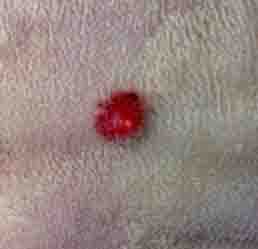Overview
Dog skin pimples caused by a mast cell tumor (MCT) are usually on the back half of the dog and are the most common type of dog skin tumor. They can be malignant tumor (50% are cancerous). Mast cells which are the cells believed to be the cause of Type I hypersensitivity (hay-fever, seasonal allergy or atopy). These types of tumors represent 20% of tumors found on dog skin.
The tumors are usually seen in dogs age 9 or older. They are known to spread or recur. Dog parents often first notice bumps on the skin or just under the skin. Teh bumps may change in size over time. In some cases the skin will appear red or ulcerated.

Symptoms
These types of tumors vary in appearance. Most tumors are ulcerated , red and hairless. It is possible that the tumor doesn't change for years, and then starts all of a sudden to grow. Since most tumors release a chemical called histamine, an accompanying symptoms is dogs presenting with an ulcer.
Diagnosis
A diagnosis is made with either a biopsy (testing of a skin sample) or the testing of a skin sample (cytology).The appearance alone does not indicate if a tumor is benign or malignant.
Treatment
The veterinarian will determine the tumors "stage" based on size. Depending on the stage treatment may be limited to surgical removal, or include radiation or chemotherapy. Surgery requires for cancerous skin tumors involves the removal of a wide margin of tissue around the mass, which can be a challenge for the patient (and Surgeon) if the mass is on the leg with a minimal amount of tissue to remove or work with.
New Drug Treatment for Dog Mast Cell Tumors
In 2020 U.S. Food and Drug Administration has approved Stelfonta (tigilanol tiglate injection) to treat dogs with non-metastatic skin-based (cutaneous) mast cell tumors (MCT) that are located on or under the skin in dogs. Treatment involves injecting Stelfonta inot the MCT via an intratumoral injection. The medication works by activating a protein that spreads through the treated tumor, disintegrating any tumor cells. The Stelfonta study had 118 dogs witth measurable subcutaneous MCT or cutaneous MC on the lower leg. Of these dogs, 80 were treated with Stelfonta and 38 were in an untreated control group. Tumor response was measured a month after the first injection. 75% of the treated dogs experienced complete remission. 18 dogs with a tumor that didn't disappear with the first injection with retreated with Stelfonta. A month after the second treatment, 445 of those dogs had their tumor completely disappear.
The site treated with Stelfonta, and as the tumor cells are killed, will cause some necrosis, or a wound and pain. Some tissue will fall off. The wound should heal normally. Ask your veterinarian about side effects since this is a powerful drug. It is administered with a corticosteroid as an H1 receptor blocking agent, and an H2 receptor blocking agent to decrease the risk of severe systemic adverse reactions, including death from mast cell degranulation.
Learn More About Stelfonta from Virbac
References Dog Skin Pimples:
Dog Owners Home Veterinary Handbook (4th Edition)
Eldredge, Carlson, Carlson and Giffin
DogWatch
Cornell College of Veterinary Medicine
